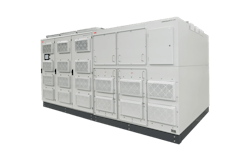Generation, Next: AI Data Centers Also Require Control of Massive Power Capacity
As the world ponders how to energize power-hungry new artificial intelligence (AI)-enabled data centers with electricity generation near and far, those same facilities require cutting-edge electrical technology to make them efficient and safe on the inside.
Data center developer Applied Digital has hired Swiss-based ABB to supply medium-voltage electrical infrastructure for the new Polaris Forge 2 campus being built in North Dakota. AI and data capacity totaling 300 MW will be spread across two buildings scheduled to come online next year and in 2027.
ABB’s first partnership agreement with Applied Digital was announced earlier this year for the 400-MW Polaris Forge 1 project in Ellendale, North Dakota. CoreWeave is leasing Polaris Forge 1.
The second data center project’s power architecture will consist of ABB HiPerGuard medium-voltage Uninterruptible Power Supply (UPS) technology and advanced medium-voltage switchgear.
The high energy intensity of AI computations is pushing data center rack capacity to unprecedented levels.
“As AI reshapes data centers, ABB is working with leading digital infrastructure innovators to introduce a new generation of advanced power system solutions,” said ABB Smart Power President Massimiliano Cifalitti in a statement. “The medium voltage architecture developed with Applied Digital is a big step forward for large-scale AI facilities. Working together closely from the start enabled both teams to identify opportunities to drive higher efficiency, performance and reliability, along with lower costs and faster time to market.”
AI technology firm OpenAI estimates that computer demand for AI training models has doubled every three to four months since 2012, which is seven times the speed of Moore’s Law on the pace of computer microchip expansion.
Therefore, power density expanding in racks and graphic processing units such as those by NVIDIA is becoming a critical metric for the data center industry. And managing that energy load is the work on internal technologies by companies such as ABB.
Applied Digital is building the 150-MW first phase of the reportedly $3 billion Polaris Forge 2 near Harwood, North Dakota. It plans to lease that facility to a U.S.-based hyperscaler. Those are massive-scale cloud-based computing providers, a small group which includes players such as Amazon, Microsoft, Google, Alibaba, IBM and Oracle. Applied Digital did not name the customer.
“Our partnership with ABB reflects Applied Digital’s commitment to redefining what is possible in data center scale and performance,” said Todd Gale, Chief Development Officer, Applied Digital. “Polaris Forge 2 represents the next evolution of our AI factory model – beginning with two 150-MW buildings with the ability to scale - solidifying our position as a leader in delivering high-performance, energy-efficient AI infrastructure.”
GoldmanSachs, McKinsey and other research organizations are predicting that future AI energy demands will push new data center capacity by 125 GW or more by the early 2030s.
NVIDIA, which leads much of the GPU market, has announced collaborations with ABB, Eaton, Hitachi Energy and others to work on future gigawatt-scale data computing facilities. Under this new collaboration, ABB will engage its expertise in direct current (DC) and solid-state electronics to support NVIDIA’s 800 VDC architecture.
Future data center power architectures will combine a medium voltage UPS and direct-current power distribution to the server room using solid-state power electronics devices, the companies say.
Many data center developers are also exploring the pairing of co-located off-grid and microgrid power generation with AI-enabled facilities. These types of near-site microgrids could help avoid lengthy utility interconnection delays.
About the Author
Rod Walton, EnergyTech Managing Editor
Managing Editor
For EnergyTech editorial inquiries, please contact Managing Editor Rod Walton at [email protected].
Rod Walton has spent 17 years covering the energy industry as a newspaper and trade journalist. He formerly was energy writer and business editor at the Tulsa World. Later, he spent six years covering the electricity power sector for Pennwell and Clarion Events. He joined Endeavor and EnergyTech in November 2021.
Walton earned his Bachelors degree in journalism from the University of Oklahoma. His career stops include the Moore American, Bartlesville Examiner-Enterprise, Wagoner Tribune and Tulsa World.
EnergyTech is focused on the mission critical and large-scale energy users and their sustainability and resiliency goals. These include the commercial and industrial sectors, as well as the military, universities, data centers and microgrids. The C&I sectors together account for close to 30 percent of greenhouse gas emissions in the U.S.
He was named Managing Editor for Microgrid Knowledge and EnergyTech starting July 1, 2023
Many large-scale energy users such as Fortune 500 companies, and mission-critical users such as military bases, universities, healthcare facilities, public safety and data centers, shifting their energy priorities to reach net-zero carbon goals within the coming decades. These include plans for renewable energy power purchase agreements, but also on-site resiliency projects such as microgrids, combined heat and power, rooftop solar, energy storage, digitalization and building efficiency upgrades.



